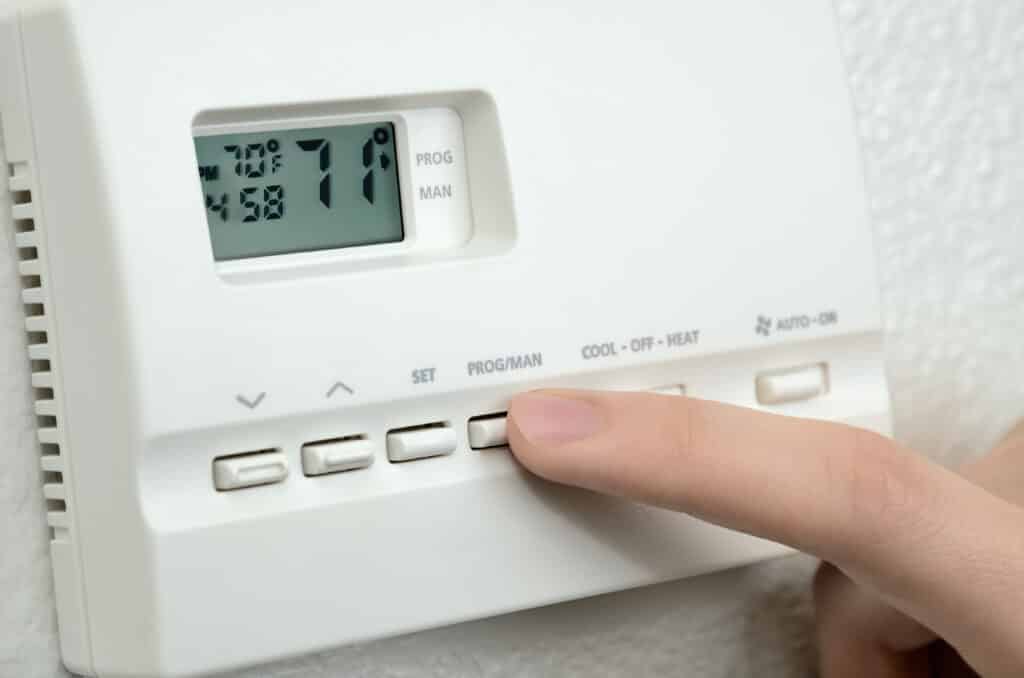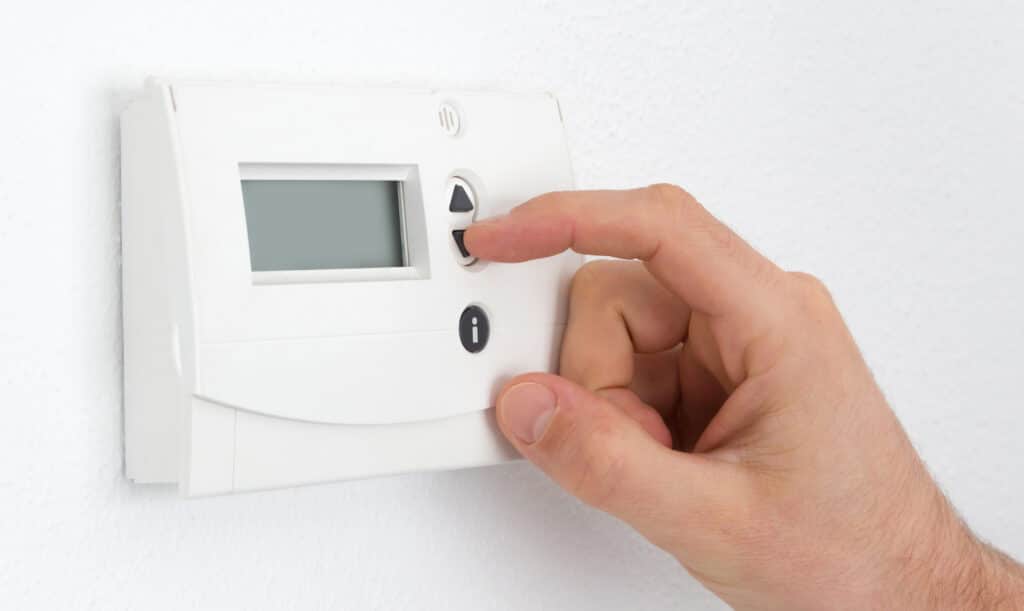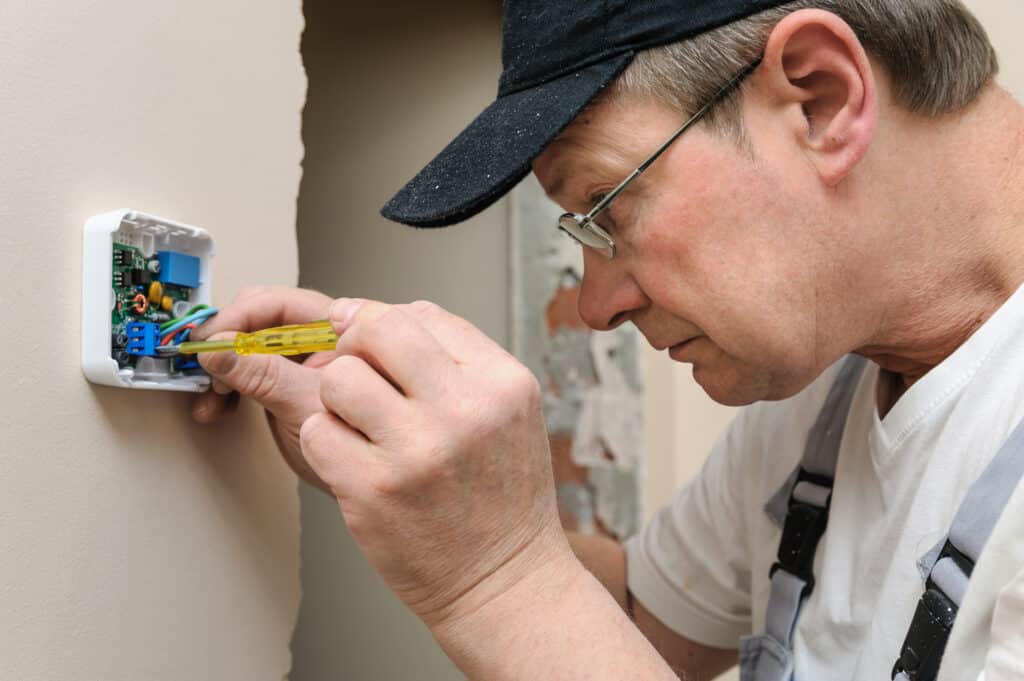Introduction
Thermostats are one of the most recognizable HVAC system parts to date. They are the easiest HVAC part to use and understand. Thermostats are simplistic and easy to use but have the potential to do so many things. For example, different types of thermostats allow users to have control over the temperatures of rooms anytime, anywhere. Some thermostats can even control room humidity and air purity. In this blog post, we will cover what thermostats are and how they work, the different categories they belong in, and common problems with them. If you have any questions after reading the blog post, feel free to comment below! We will try to do our best to answer them.

What Are They and How Do They Work?
A thermostat is an HVAC part that monitors the temperature in a room and adjusts it when needed. It maintains a constant temperature or changes temperature based on an HVAC owner’s input. Whenever the temperature in a room changes, the thermostat sends a message to the HVAC system. The HVAC system receives the message and then responds by heating or cooling a room. The faster the HVAC system receives a message, the faster it can start working on the changes. Some thermostats are also able to control room humidity and air purity, as mentioned above, but the majority of them currently do not. Most thermostats today are just messengers to HVAC systems. While thermostats are simplistic and focus on a singular task, they are incredibly important.
Without thermostats, an HVAC system would not be able to function. HVAC systems need thermostats because they send crucial instructions to the system. They are necessary components in order for them to run.

The Different Categories of Thermostats
Thermostats are often separated into two categories: programmable and nonprogrammable. Programmable thermostats are thermostats that can store different temperatures depending on an HVAC owner’s settings. They save these temperatures and see if they follow a pattern, such as if a homeowner is more likely to lower the temperature in their home or not at night. If the temperatures do follow a pattern, then a programmable thermostat will learn it and automatically adjust the temperature of a room. This saves HVAC owners time and money as the thermostat can shut itself off when it is not normally in use. HVAC owners are able to adjust the temperatures or change them all together without any risk of ruining other settings. Energy.gov explains it as “Programmable thermostats can store and repeat multiple daily settings that [an HVAC owner] can manually override without affecting the rest of the daily and weekly program.”
Nonprogrammable thermostats, on the other hand, cannot store different temperatures and have to be adjusted manually. They are easier to use and tend to be cheaper than programmable thermostats. While programmable and nonprogrammable thermostats are not different types of thermostats but merely categories to sort them in, they are still important distinctions that help to explain how they work.

Common Problems with Thermostats
- Dead Batteries
If your thermostat is battery-powered and its batteries are dead, it will no longer be able to work. The batteries in a battery-powered thermostat allow the thermostat to do two things: show its display and communicate with the air conditioner and furnace. While this is not the case for all makes and models, it is for most. If you notice that your thermostat is not showing its display or communicating with your air conditioner and furnace, try replacing the batteries in it. If it works after replacing the batteries, great! The issue is likely related to something else if it is not.
- Dusty
When dust gathers inside your thermostat, it can affect it in many ways. In fact, it can cause your thermostat to misread the room’s temperature, stop communicating with your air conditioner and furnace, and raise your energy bills. If you notice these things happening, it might be time to dust your thermostat.
Here are the steps to dusting your thermostat:
- Turn off your thermostat.
- Dust the exterior of it with a small brush.
- Gently remove the plate of your thermostat to access the interior of it.
- OPTIONAL – If you have compressed air available on hand, use it to dislodge some of the hard to remove dust in the interior.
- Carefully wipe the dust from it, keeping in mind its wiring.
- Place your thermostat’s case back on.
- Turn on your thermostat.
While dusting your thermostat is a great way to troubleshoot problems with it, it is also a good thing to incorporate into your regular maintenance of your HVAC system.
- Improperly Positioned
If your thermostat is improperly positioned, it will not be able to read the room’s temperature correctly. An improperly positioned thermostat could be one that is on an exterior wall, near a door, window, or anything that produces hot or cold air. These factors can affect a thermostat’s ability to accurately gauge the temperature of a room.
Before installing your thermostat, make sure there is nothing that might affect its ability to read the room’s temperature. If you cannot move your thermostat, try to minimize the effects of its poor position. For example, move anything that produces hot or cold air, install curtains to cover up your windows as needed, and keep windows and doors closed. If you cannot do these things, keep in mind your thermostat will always be a little off when reading the room’s temperature. You will have to adjust it as needed.

Conclusion
In this blog post, we discussed what thermostats are, how they work, the different categories they belong in, and some common problems with them. We hope this blog post helped you understand thermostats a little bit more and answered any questions you may have had about them. Are you having trouble with your HVAC system and live in St. Louis County or the surrounding areas? Give us a call! Our number is 636-475-9384. We are available Monday through Friday, 6:00 a.m. to 6:00 p.m. We offer 24-hour emergency service as needed.